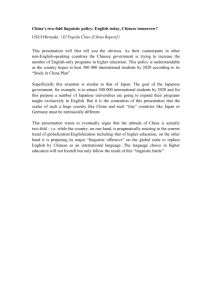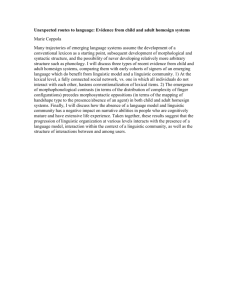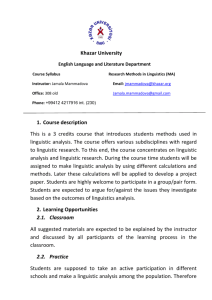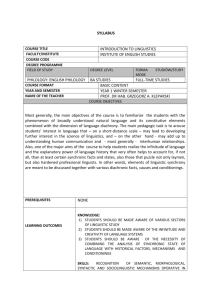Lexicon-driven Ontology and Conceptual Structure
advertisement
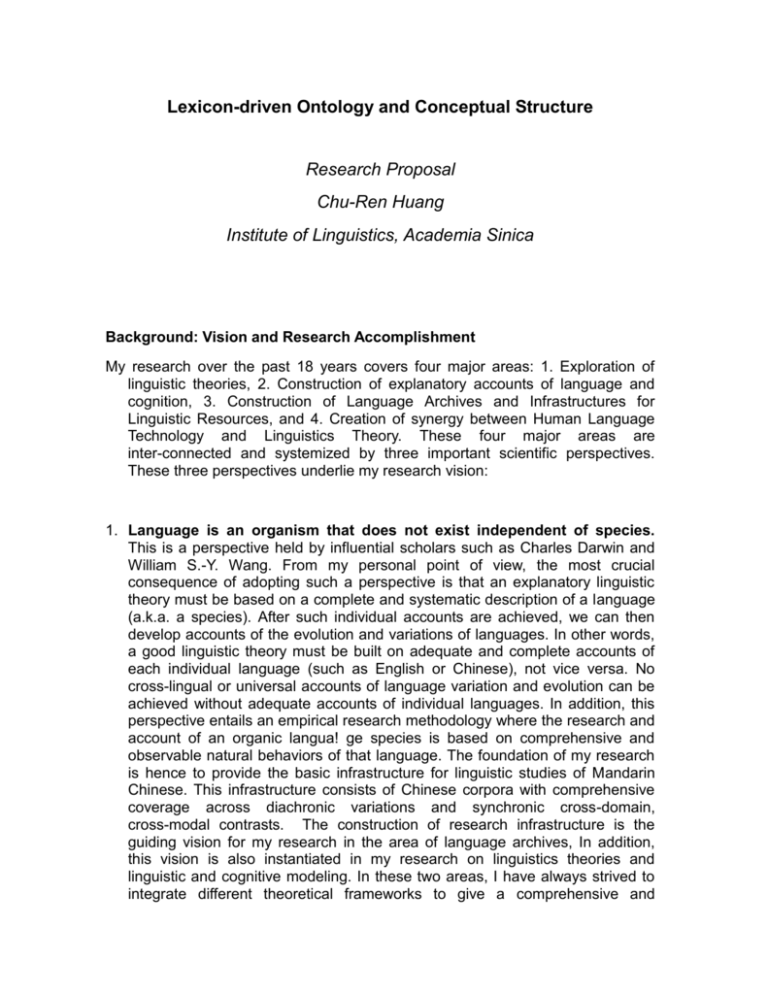
Lexicon-driven Ontology and Conceptual Structure Research Proposal Chu-Ren Huang Institute of Linguistics, Academia Sinica Background: Vision and Research Accomplishment My research over the past 18 years covers four major areas: 1. Exploration of linguistic theories, 2. Construction of explanatory accounts of language and cognition, 3. Construction of Language Archives and Infrastructures for Linguistic Resources, and 4. Creation of synergy between Human Language Technology and Linguistics Theory. These four major areas are inter-connected and systemized by three important scientific perspectives. These three perspectives underlie my research vision: 1. Language is an organism that does not exist independent of species. This is a perspective held by influential scholars such as Charles Darwin and William S.-Y. Wang. From my personal point of view, the most crucial consequence of adopting such a perspective is that an explanatory linguistic theory must be based on a complete and systematic description of a language (a.k.a. a species). After such individual accounts are achieved, we can then develop accounts of the evolution and variations of languages. In other words, a good linguistic theory must be built on adequate and complete accounts of each individual language (such as English or Chinese), not vice versa. No cross-lingual or universal accounts of language variation and evolution can be achieved without adequate accounts of individual languages. In addition, this perspective entails an empirical research methodology where the research and account of an organic langua! ge species is based on comprehensive and observable natural behaviors of that language. The foundation of my research is hence to provide the basic infrastructure for linguistic studies of Mandarin Chinese. This infrastructure consists of Chinese corpora with comprehensive coverage across diachronic variations and synchronic cross-domain, cross-modal contrasts. The construction of research infrastructure is the guiding vision for my research in the area of language archives, In addition, this vision is also instantiated in my research on linguistics theories and linguistic and cognitive modeling. In these two areas, I have always strived to integrate different theoretical frameworks to give a comprehensive and systematic account of one language. The integration of different theoretical approaches are necessitated and driven by the requirement of a comprehensive account of the natural linguistic system. 2. A functional account of language must be based on the structural representation of knowledge. The most salient advantage of the human species as well as its achievement over other species is the discovery, accumulation and inheritance of knowledge. This systematic discovery of knowledge, as well as its accumulation and inheritance is achieved through the mediation of language. Thus, the most critical scientific explanation of language involves how language represents knowledge structure and how language communicates knowledge. This is not unlike the goal of genomic studies, where the goal is not only to discover genomic sequencing but also to find out account of the function of each segment. Only functional accounts based on knowledge and conceptual structure can lead the way toward the integration of formal theory of language with psychological and cognitive models of language. The same approach can be applied to knowledg! e engineering and processing in order to better the life of human beings in the future. In other words, the structural representation of knowledge will be the shared explanatory basis for (1) linguistic theory, (2) models of language and cognition, (3) construction of language archives and linguistic resources, and (4) human language technology. 3. Words are atoms in both representation of and access to linguistic knowledge. Regardless of whether the theoretical premise of modularity is assumed or not, the fact that a linguistic system involves multiple levels of form and meaning is never challenged. Language necessarily involves brain functioning such as neural signaling, articulatory physiology, acoustic phonetics, morphological derivations, syntactic structure, semantic information, logic, social contexts, etc. This is exactly why language is fascinating. But, how can these rich and diversed levels be compatible within one singe knowledge system? Psychologists have long assumed the existence of the mental lexicon as the basic locus for knowledge storage and access. Computational linguists also have a long tradition of relying on lexical knowledgebase to provide linguistic information needed for processing. In theoretical linguistics, even though lexial-driven gram! matical theories did not gain full attention until the late 1980's, a lexicon-driven theory of language change and variation was already developed in the 1960’s by William Wang and his colleagues. Their theory of lexical diffusion was motivated by the fact that all factors that may contribute to language variations are changes that converge on the lexicon. From this perspective, we can clearly see that all levels of linguistic knowledge can be concretely represented in the lexicon. In terms of either on-line or off-line experiments on human cognition, as well as in terms of formal theories of language, as well as computational simulation, a lexicon provides substantive empirical objects for both testing and verification. In addition, the enumerating nature of a lexicon also lays the foundation for the results to be robust and scalable. My research accomplishments in these four areas are listed below: 1. Exploration of linguistic theories My early research concentrates on understanding and integrating different linguistic theories. Based my research expertise covering three grammatical theories, I have focused in the past years on developing a theory as well as a representational framework for lexical semantics. I attempt to approach the issue with a comprehensive account of the facts of a language, and develop an sense and meaning driven account of the data. The theory accounts for semantics, morphology, syntax, as well as how they interact to generate actual linguistic behaviors. The important accomplishments in the past include: 1) Pioneering the application of GPSG (Generalized Phrase Structure Grammar) to the study of Mandarin Chinese and Southern-Min. I was involved in the development of the theory of GPSG. From 1984 to 1991, I published one book, 5 journal papers, and over 10 conference papers using this theory. 2) Pioneering the application of LFG (Lexical Functional Grammar) theory in the study of Mandarin Chinese. I was involved in the development of the theory as well as studies to apply the theory to computational linguistic research. From 1985 to 1997, I published one book, 7 journal papers, and over 30 conference papers adopting LFG. 3) Introducing the theory of CG (Construction Grammar). From 1995 to 1999, I published on journal paper and 3 conference papers using this theory. 4) Developed and proposed The Module-Attribute Representation of Verbal Semantics (MARV).This theory integrated the empirical research methodology of corpus linguistics and adopted a verbal semantic representational model that is event-driven. They theory also established a framework to predict the behavior and distribution of syntactic forms based lexical meaning. From 1996 on, I have published 10 journal papers and over 20 conference papers in this theory. 2. Construction of explanatory accounts of language and cognition An explanatory account of language and cognition is one of the most fasinating research issues in the scientific study of language. I have adopted both a mathematical model (Huang1989)as well as a simulation of a psychological model based on large quantity of corpus data(Huang, Ahrens, and Chen 1998, etc.)in order to approach an explanatory account. My recent, and hopefully more significant, contribution is to try to free my research from the constraints of formalized theories and instead concentrate on pursuing explanations to two uniquely human facts in language cognition. These two facts are the inherent ambiguity in human languages and the use of linguistic metaphor. The crucial issue involved in ambiguity in human language is the fact that all artificial languages and formal communication systems eliminate ambiguity by design, yet human languages contain ambiguity by nature. In other words, ambiguity is a unique design feature of human languages. Since ambiguity reduces the effective informational load, it cannot be motivated in an efficient driven theory such as the Communication Theory of Shannon. I started out trying to determine the nature and complete behavior of ambiguity in a specific language. From 1996, I have studied the complete data involving categorical ambiguity in the five million word Sinica Corpus. Based on the analysis of all the instances of categorical ambiguity, several generalizations as well as explanatory accounts were proposed; I also proposed two definitions of ambiguity, with one referring to the potential for a certain linguistic element to be ambiguous, whereas the other refers to the! complexity of ambiguity when it does occur. My findings demonstrate that the degree of ambiguity, with regard to potential of an element to be ambiguous, is dependent on its frequency and category, but irrelevant to the number of categories in the classification system. On the other hand, the degree of ambiguity with regard to the complexity of ambiguity is dependent on the category of that element as well as the number of categories used in the classification system. I proposed an explanatory account of the above generalizations integrating evolutionary perspectives in Huang (2004). Metaphor, on the other hand, is the use of knowledge or conceptual structure based on more familiar or concrete domains to describe an element form a unfamiliar or more abstract domain, such as ‘LIFE is a JOURNEY.’ What metaphor offers is a way for human being to ‘map’ from the knowledge of a familiar domain to a new and unfamiliar domain. Adopting a mapping model will allow us to verify and explain how knowledge is structured in human cognition. We (including Kathleen Ahrens, and Siaw-fong Chung) pioneered the research method of extracting metaphors from corpora, and adopting the structure of an upper ontology to explain and account t for the mapping. Our group has designed both on-line processing as well as ontology-based test to verify our account. I have al! ready published 4 journal papers and over 10 conference articles in this area. 3. Construction of Language Archives and Infrastructures for Linguistic Resources Language archives are both the foundation and last resort for sustaining cultural tradition as well as saving endangered languages. In addition, they also provide an essential infrastructure for empirical studies of languages . Lastly, they represent the obligatory resources utilized in language technology an d knowledge engineering. I have directed or co-directed (collaborated mostly with Keh-jiann Chen and other colleagues) the completion of the following language archives: 1) Academia Sinica Balanced Corpus of Modern Mandarin Chinese (Sinica Corpus): This is the first Chinese corpus in the world to have grammatical category tagging (1994); it is also the first corpus in the world to be fully accessible on the web (1996). It has become a basic tool in computational and theoretical studies in Chinese linguistics. 2) Sinica TreeBank (2001): This is the first syntactically annotated Chinese corpus as well as one of the first corpus marked with argument role information in the world. 3)Academia Sinica Bilingual Ontological WordNet (Sinica BOW 2003): This is the first complete English-Chinese bilingual wordnet as well as the first wordnet to be fully integrated with an ontology. Additional accomplishments include the proposal, overseeing and implementation of the ‘Language Archives’ and ‘Linguistic Anchoring of Digital Archives’ project under the National Digital Archives Program. The pioneering design provided linguistic anchoring in addition to the conventional spatio-temporal coordinates and prepared a foundation for rich and effective content manipulation. I also bridged our research with the current state of the art in the world for digital archives. I am involved in the Open Language Archives Community (OLAC), serving first as a consulting committee member before becoming one of the founding executive council members. I am also the founding co-chair of the Asian Language Resources Committee. Last, but not the least, I have also spearheaded the use of language archives in a web-based learning environment. Of the three completed language learning resources sites that I directed or co-directed, ‘the adventures in Wen-land’ is worth noting. Since its inauguration at the end of 2002, it has received over quarter of a million visits, mostly from grade school teachers and students. 4. Creation of synergy between Human Language Technology and Linguistics Theory I have played a central role in the development and promotion of Chinese computational linguistics since 1987. On one hand, I strive to bring up the research in Taiwan to international standard, and raise the visibility as well as influence of Chinese language processing in the field at the same time. On the other hand, I aim to find a optimal synergy between rule-based linguistic account and stochastically oriented computational studies, promoting studies that are both theoretically significant but robust enough for computational applications. One of the most significant milestone achieved is my organization of COLING2002, the premier computational linguistics conference, in Taipei. In this area, I have published two compiled books, edited 4 journal special issues, published 20 journal papers and over 40 conference papers. Other significant accomplishments include drafted the national standard for Chinese segmentation for information processing (CNS14366, 1999), the proposal of the ICG (Information-based Case Grammar) framework in conjunction with Keh-jiann Chen, construction of a lexical knowledgebase based on ICG(CKIP Lexicon,1998)。In the past two year, my study on lexical semantics and lead to a set of theoretically felicitous criteria for differentiating senses in Chinese as well as a set of operational criteria, which have been applied to a large scale Sinica Sense Management System. Current Research Focus 1. A sense-based grammatical and knowledge presentation system, and construction of sense-based KnowlegeBase for Mandarin Chinese Based on the three research perspective outlined at the beginning of this proposal, what would be essential for my research and for the scientific study of language in general is a corpus that contains comprehensive coverage of linguistic content (i.e. meaning and sense) as well as linguistics forms (i.e. including morphological . phonological, and syntactic items) from one particular language. Such a corpus must be built upon a complete and robust theory or lexical semantic and representational framework, has a comprehensive coverage of all lexical items, and has rich yet felicitous semantic markup. Works in progress include 1) The lexical semantic representational theory of MARVS. It has already been developed and has been verified and modified based on on-going studies. 2) The criteria and operational principles for sense differentiation has been proposed, Studies are carried out to explore the possibility of automatic taggeing of senses in Chinese. 3) Completed the design and implementation of a sense-mangement system for Sinica Corpus. We have completed analysis and account of over 2,000 senses in Mandarin Chinese and have designed and implemented the Sinica Senase Management system. 2. Comparative Studies of lexicon-driven conceptual structures and ontologies Once we established the definition and how to differentiate word sense, we will be able to carry out systematic comparative studies of conceptual structures and knowledge structures. The research topics will include: 1) A complete linguistic knowledge structure of Chinese based on word senses. This study largely follows the WordNet paradigm set up by George Miller, Christiane Fellbaum and colleagues at Princeton University for English. The basic idea is that the complete network of semantic relations extended and linked from the complete inventory of word senses in a language represent a conceptual shared by speakers of that language. We have established theory to identify senses and semantic relations in Chinese in our ongoing research and will build up the semantic network of Chinese wordnet based on our thorough and robust account of the word senses in Chinese. 2. A contrastive study of cross-lingual semantic relations. Based on the framework of WordNet, I argued earlier(Huang et al. 2003)that cross-lingual translation equivalents must also be described in terms of semantic relations. We are now constructing bilingual wordents, A bilingual wordnet with semantic relation tagging will enable us to pursue studies of comparative and contrastive studies of the different knowledge structures between two languages. 3. Comparative studies of the structural correspondences between conceptual structures and lexical knowledge. The study of conceptual structure has been a favorite topic in cognitive sciences. However, even though there have been a few theories of conceptual structures, none has become a commonly accepted standard. In computer science, ontology was proposed to provide a shared framework for knowledge exchanges. SUMO (Suggested Upper Merged Ontology), a upper ontology construction was sanctioned by IEEE, offers a promising shared representational scheme that can overcome both domain and language barriers. It can also serve as the reference point to compare two different knowledge systems. Our recent study has not only verified a Chinese version of SUMO but also verified the conceptual links from over 100,000 Chinese lemmas to SUMO nodes. This resource allows the conceptual location of each Chinese lexical term to be determined. In terms of comparative studies of knowledge systems, we also completed a pilot study based on 300 Tang Poem (Huang et al. 2004). In this study we propose method to construct domain ontology based on domain lexicon. The constructed domain ontology facilitates a global comparison of knowledge structures and allows a holistic understanding of the knowledge structure of that domain. Future Research Plan Lexicon-driven Ontology and Conceptual Structure The success of a lexicon-driven research is dependent on the completeness and quality of the lexical knowledgebase. Hence my research will starts with building such lexical knowledgebases to allow diachronic, cross-lingual, and cross-domain study of knowledge systems. 1. Construction complete periodical historical Chinese lexicons. This will be the basic resource for diachronic comparative studies of Chinese texts. It will also allow Academia Sinica to lay another milestone in Sinological studies, and maintain its lead in innovation in the field. This research will be carried out in collaboration with Peichuan Wei, Keh-jiann Chen, CC Cheng, Chenghui Liu, Feng-ju Lo, Lili Chang. 2. Construction of ontology-based, cross-domain and historical knowledge systems. Based on the constructed ontologies, we will also study establish a framework and methodology of descriptive and comparative studies of knowledge systems based on ontology. The preliminary plan is to concentrate on plants terms in historical texts. This study will be carried out in collaboration with CC Cheng and Feng-ju Lo, as well as interested botanists. 3. Application of the research results integrating lexical semantics and ontology to the Semantic Web. When the Semantic Web and its related technologies mature, it will popularize the juxtaposition of web technology and ontology. It is conceivable that web usage will entail dealing with ontology at that stage. Our basic research on lexical semantics and ontology can be applied to the following issues of Human Language Technology: (1) Multi-lingual and cross-lingual information processing (2) Meaning-driven knowledge acquisition (3) Interpretation, and value-added reproduction of human knowledge Significance of your Inter-disciplines research in your discipline or In linguistic studies, this research will establish a paradigm based on Mandarin Chinese corpora, and driven by lexical sense and knowledge structure. It will establish word as a linguistic unit corresponding to conceptual atoms and hence the natural unit to account for both communication and processing of linguistic knowledge. In terms of inter-disciplinary studies of human language technology, this study will establish a lexicon-driven infrastructure of ontology for both Chinese and multi-lingual processing. It will facilitate future studies that can overcome the language gap, and offers the foundation for synergy between Human Language Technology and human cognitive theory.
